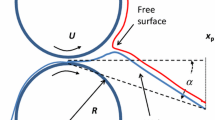Abstract
This paper describes the theoretical modeling for the prediction of slippage onset condition between the paper web and steel roller with experimental verifications. For the first step of modeling, the occurrence of slippage is observed for the cases of uncoated paper (newsprint) and coated paper, and the relation between the slip ratio and roller velocity is measured by changing web tension. Two kinds of theoretical model are proposed, and the applicability of the models is confirmed experimentally.












Similar content being viewed by others
Abbreviations
- B :
-
web wrap angle (rad)
- d :
-
shape function (m)
- F :
-
friction force between web and roller (N)
- f :
-
traction force at bearing (N)
- h :
-
entrained air film thickness (m)
- k :
-
web permeability (m2)
- L :
-
web width (m)
- M b :
-
bearing torque (Nm)
- p :
-
air film pressure (Pa)
- p a :
-
ambient pressure (Pa)
- R :
-
roller radius (m)
- r :
-
bearing radius (m)
- s :
-
slip ratio
- T :
-
web tension (N/m)
- t w :
-
web thickness (m)
- U :
-
total velocity (= U r + U w ) (m/s)
- U r :
-
roller velocity (m/s)
- U slip :
-
slip onset velocity (m/s)
- U w :
-
web velocity (m/s)
- w :
-
web deflection (m)
- x :
-
coordinate in the web transport direction (m)
- x e :
-
outlet position of web wrap angle (m)
- x s :
-
inlet position of web wrap angle (m)
- z :
-
coordinate in the cross machine direction (m)
- η :
-
air viscosity (Pa s)
- μ :
-
traction coefficient between web and roller
- μ b :
-
bearing friction coefficient
- μ l :
-
local traction coefficient
- σ :
-
rms composite roughness (m)
- σ r :
-
rms roughness of roller surface (m)
- σ w :
-
rms roughness of web surface (m)
References
Ducotey KS, Good JK (1995) The importance of traction in web handling. Trans ASME J Tribol 117:679–684
Ducotey KS, Good JK (1999) Predicting traction in web handling. Trans ASME J Tribol 121:618–629
Hashimoto H (1999a) Air film thickness estimation in web handling processes. Trans ASME J Tribol 121:50–55
Hashimoto H (1999b) Improvement of web spacing characteristics by two types of guide rollers. Proceedings of the 5th international conference on web handling, pp 561–581
Hashimoto H, Nakagawa H (2001) Improvement of web spacing and friction characteristics by two types of stationary guides. Trans ASME J Tribol 123:509–516
Hashimoto H (2005a) Theoretical modeling of traction characteristics between paper-web and steel-roller based on the contact mechanics. Proceedings of the eighth international conference on web handling, pp 1–18
Hashimoto H (2005b) Mechanism of paper handling. J JSME 108:1
Hashimoto H, Okajima M (2006) Theoretical and experimental investigations in to spacing characteristics between roller and three types of webs with different permeabilities. Trans ASME J Tribol 128:267–274
Author information
Authors and Affiliations
Corresponding author
Additional information
For the presentation at 2006 ASME/JSME Joint Conference on Micromechanics for Information and Precision Equipment (MIPE2006) and for publication Special Issue MIPE2006 of Journal of Microsystem Technology.
Rights and permissions
About this article
Cite this article
Hashimoto, H., Ibi, Y., Kiribe, S. et al. Prediction of slippage onset condition between web and steel roller. Microsyst Technol 13, 965–971 (2007). https://doi.org/10.1007/s00542-006-0293-x
Received:
Accepted:
Published:
Issue Date:
DOI: https://doi.org/10.1007/s00542-006-0293-x




